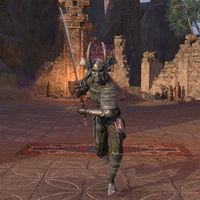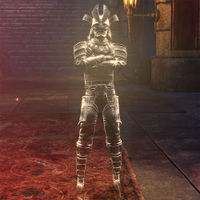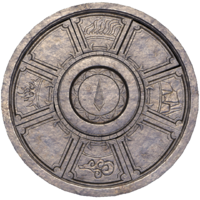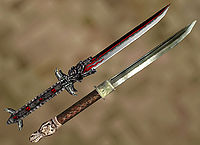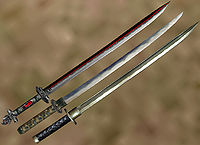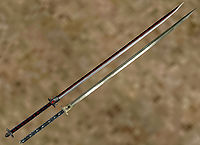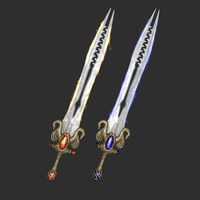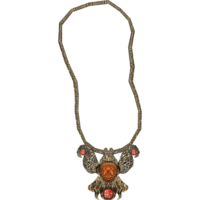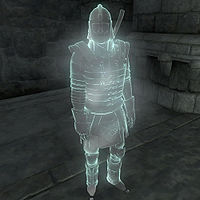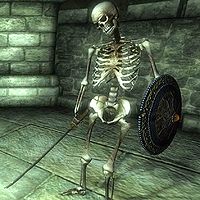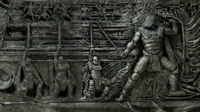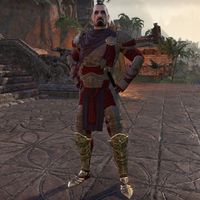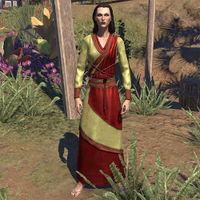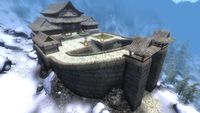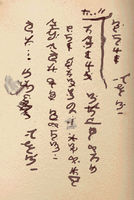Lore:Tsaesci (race)
The Tsaesci (Snake Palace; /ˈseɪ.ʃi/ say-she (listen⏵), /ˈseɪ.ə.si/ SAY-ess-see,[1] /ˈseɪ.tʃi/ say-chee (listen⏵),[2] or /ˈzi.ʃi/ zee-she),[UOL 1] also known as the serpent-folk or snake men, are a race originating from the continent of Akavir, east of Tamriel. While the racial status of the Tsaesci is ambiguous, with some sources claiming them as a human race[3] while others claim them as a race of beastfolk,[4][5] all known encounters with Tsaesci show they are at least a race of humanoids, with some looking indistinguishable from humans. However, the possibility of Tsaesci being shapeshifters further increases the ambiguity of their status.[2]
Black hair is a known genetic trait of the Tsaesci,[6] with some claiming them to also have scaly feet.[7] Sources which identify the Tsaesci as beastfolk attribute to them other physical traits such as tails, and describe them as having the bodies of "inverted gorgons".[4][8][Note 1] Adding to these contradictory claims, it is also claimed that the so-called serpent-folk apparently not only "ate" the men that lived on Akavir (although this statement can be interpreted in many ways), but also resemble them. Numerous legends shroud the origins of the Tsaesci. Some claim their forebears fell prey to a vampiric serpent race, while others suggest they were captured by them.[5][9][Note 2]
Although immortality is attributed to them in literature,[5] descendants of Tsaesci refugees in Elsweyr claim that longevity is not a trait of the race and speculate that the longevity of figures such as the Potentates had magical origins.[10]
Individuals with Tsaesci and Imperial ancestry are said to be barely distinguishable from their pure Cyrodilic cousins, with the eyes and hair being the most recognizable traits of Tsaesci ancestry.[6]
History[edit]
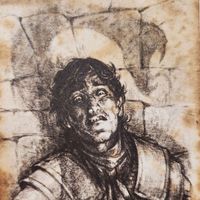
The Anuad creation myth asserts that the Wandering Ehlnofey were divided onto three continents, with the descendants of those on Akavir becoming the Tsaesci (and therefore related to the Yokudans and Atmorans).[3] The Tsaesci once invaded Tamriel in 1E 2703, but were driven back by the forces of Emperor Reman I.[11] Surviving Tsaesci in Cyrodiil served as mercenaries and personal guards of nobles.[12] They left many influences on Imperial institutions and culture, including the doctrines and equipment of the Imperial Legion, the creation of the Akaviri Dragonguard (a personal bodyguard organization for the Emperor) and Fighters Guild, a reverence among the Imperial aristocracy for all things Akaviri, and the adoption of the dragon as a symbol of the Empire.[Note 4] A number of Tsaesci even served the Second Empire as Potentates, among them Sidri-Ashak, Versidue-Shaie, and Savirien-Chorak. The latter two ruled the Second Empire outright during the first half of the Second Era, a period known as the Akaviri Potentate that was brought on by the demise of the Reman Dynasty.[13]
After the fall of the Akaviri Potentate in 2E 430 most Tsaesci fled Cyrodiil, joining other Akaviri that lived in Rimmen and the surrounding area. These Akaviri would later be known as Rim-Men[14] and would help the resurfaced Dir-Kamal armies to conquer Cyrodiil.[15]
Society[edit]
Ancestor worship seems to be an integral part of Tsaesci culture.[16][17] They believe that all waterways connect the worlds of the living and the dead and from them the spirits of their ancestors gaze upon their living descendants and their deeds,[18] thought to grant either good fortune or misfortune depending on whether the actions of their progeny have pleased them. Thus water occupies a special place in Tsaesci faith. One's ancestors are invoked by calling their name during the Proving Festival, a date on which it is said it is possible for spirits to cross over from the afterlife into the living world. Ancestor spirits are said to grow more powerful the more they are revered, thus a well-honored ancestral spirit will be able to cross from the afterlife into the living world more easily, take on different forms such as that of a black bladed golden warrior that is "swift as the wind", grant great fortune or misfortune, commune through and alter dreams, and even drag one to the afterlife if angered. Thus ancestor spirits are viewed as something to be appeased, able to render significant aid if properly honored but also dangerous if offended, known to deliver potentially fatal trials for what they consider insulting behaviour such as verbal boasts of greatness that disrespect the dead.[19][20][21] Spirits might also return to the living world for other reasons, such as taking action to maintain their own legacy, whether based on truth or not.[22][23]
The Rim-Men of Hakoshae, a community of Imperials with claims of Tsaesci descent, maintained what they believed was the Tsaesci tradition of ancestor worship. In 2E 582, they revived the Proving Festival—an Akaviri holiday where supplicants prove their wisdom, strength, and honor to their ancestors.[22][23] The Proving Festival is an important, yearly holiday of the Tsaesci to appease the ancestors and prove one's worth.[16] It consists of three proofs which a participant has to pass: The first is the Proof of Reverence by which the ancestors are invoked and invited to enter the living world as spirits. The Rim-Men let a paper lotus be carried down a river. The lotus symbolically swims into the realm of the dead to attract the attention of the ancestors.[18] The second proof is the Proof of Strength. It serves to show the ancestors one's strength and that one can resist various dangers.[24] The last proof is the Proof of Wisdom. Traditionally it consisted of scholars drafting grand essays, writers composing ornate poems or philosophers performing lengthy debates. However in Hakoshae the inhabitants use riddles for that purpose.[25]
In addition to reverence of the ancestors, at least four deities, symbolizing different elements, are known: Ilni (weather/air), Myn (sun/fire), Nyfa (earth), and Zisa (oceans/water).[26] Z'en might also be worshipped by the Tsaesci, as origins of his mythology can be traced back to Akavir.[27]
Tsaesci are known to have had marriage,[28] a tradition they shared with the Rim-Men.[29] Unlike the other races and cultures on Nirn, the Tsaesci do not follow the tradition of constellations in accordance with their "subdermal culture", meaning none of them possess birthsigns.[UOL 2]
The Tsaesci are known for their use of magic.[10][24] Additionally, they utilize a special magic called 'kiai',[Note 3] which shares similarities with Shouts of the Nordic Thu'um.[30] Known for their resistance to poison and prowess in combat, tales even speak of their mastery over Dragons, purportedly enslaving the mighty beasts.[9] Specfically they are known to have enslaved red dragons, who they use as war mounts.[5][12] Additionally, they are are known to enslave the goblins of the isles surrounding their land, who they use for labor and fresh blood.[5]
Arms and Armor[edit]
Two Akaviri "Blood Drinker" swords, known as Dawn/Duskfang and Bloodthirst, emulate the rumored traits of their Tsaesci creators. Although some sources claim Tsaesci fight without shields or armor, using only swords such as the Dai-katana in combat,[31][32] eye-witness accounts from the battle at Pale Pass describe the Tsaesci not only using armor and shields, but also various types of weapons.[33] The nature of the race is a tapestry of historical contradictions, so what little is known about them is uncertain. However, all known encounters with the Tsaesci have not only confirmed that they are humanoids, but that they also use armor and shields in combat. However, the Tsaesci use shields mostly as a form of ceremonial and decorative armor, and don't find widespread use in combat.[34]
Akaviri katanas, while elegant and efficient, are too expensive and sophisticated a weapon to be popular with the Legions or hero-adventurers. Well-heeled nobles, collectors, and swordmasters prize the blade for its superior balance and effectiveness.[35] However, they are part of the standard arms for members of the Blades.
The tanto is a stylish dagger variant of Akaviri design. For obscure reasons, the Telvanni prefer them to standard daggers as a matrix for their enchantments, and Telvanni mercenaries are often equipped with enchanted tantos by their mage-lord patrons.[35]
The wakizashi is an elegant and refined single-edged version of the more common double-edged longswords of Western design. Because the weapons themselves are rare, and few smiths know how to make them, they are not common. [35]
Gallery[edit]
Depictions[edit]
Other[edit]
-
A Rim-Man wearing traditional Tsaesci clothes (ESO)
-
Cloud Ruler Temple, an ancient Blades stronghold
Notes[edit]
- "Xhiado Kas" is a known Tsaesci title for The Flame Maiden, given to Luciana Pullo.[36]
- Diagna's cult originated in Yokuda during the "Twenty Seven Snake Folk Slaughter".[27] Whether the "Snake Folk" were the same as the Tsaesci serpent-folk is unknown. Carlovac Townway once asserted that Redguard culture and their greatest heroes have been heavily influenced by Akaviri and Tsaesci culture, specifically citing Gaiden Shinji, a leader of the Order of Diagna, as an example of this cultural exchange.[UOL 3]
References[edit]
- ^ Grommok's Journal — Grommok gro-Barak
- ^ a b ESO Live "Episode 2". Retrieved 2025-01-20.
- ^ a b The Annotated Anuad
- ^ a b 2920, The Last Year of the First Era — Carlovac Townway
- ^ a b c d e Mysterious Akavir
- ^ a b Meet the Character - Chevalier Renald — Abnur Tharn
- ^ Chronicles of the Five Companions 8 — Abnur Tharn
- ^ 36 Lessons of Vivec, Sermon 7 — Vivec
- ^ a b Kiseravi's dialogue in ESO: Elsweyr
- ^ a b Avita Pitio's dialogue from Elder Scrolls Online: Elsweyr
- ^ Pocket Guide to the Empire, 3rd Edition: Other Lands — Imperial Geographical Society, 3E 432
- ^ a b Pocket Guide to the Empire, 1st Edition: Cyrodiil — Imperial Geographical Society, 2E 864
- ^ Pocket Guide to the Empire, 3rd Edition: The Seat of Sundered Kings: Cyrodiil — Imperial Geographical Society, 3E 432
- ^ The Tonenaka Shrine — Magnate Feina-Darak
- ^ Pocket Guide to the Empire, 1st Edition: The Elsweyr Confederacy — Imperial Geographical Society, 2E 864
- ^ a b The Proving Festival — Laije-Palak Rulician
- ^ Magnate Feina-Darak's dialogue from Elder Scrolls Online: Elsweyr
- ^ a b Domitia Nasica's dialogue from Elder Scrolls Online: Elsweyr
- ^ Clever Kail-Perwa and the Great Boast — Nalae-Polek, Poet Laureate to Potentate Versidue-Shaie
- ^ Proconsul Beloren-Kaie's appearance in ESO
- ^ The Proving Festival — Laije-Palak Rulician
- ^ a b Magnate Feina-Darak's dialogue in ESO
- ^ a b Descendant of the Potentate quest in ESO
- ^ a b Vek-Drassi Secunia's dialogue from Elder Scrolls Online: Elsweyr
- ^ Valoria Marius' dialogue from Elder Scrolls Online: Elsweyr
- ^ Tale of the Elements — Nalae-Polek, Poet Laureate to Potentate Versidue-Shaie
- ^ a b Varieties of Faith... — Brother Mikhael Karkuxor of the Imperial College
- ^ Akaviri Diary Translation — Xhaferi
- ^ Ashur's dialogue in ESO
- ^ Children of the Sky
- ^ a b 2920, Morning Star — Carlovac Townway
- ^ History of the Fighters Guild
- ^ Crafting Motif 92: Ancestral Akaviri Style — Caelius Calogerus, Imperial Captain
- ^ Crafting Motif 53: Tsaesci Style — Kiasa-Veda, the Chronicler of Blades, Dir-Tonenaka
- ^ a b c Garothmuk gro-Muzgub's dialogue in Morrowind
- ^ Meet the Character - Proctor Luciana — Grimrald Brassbones
Note: The following references are considered to be unofficial sources. They are included to round off this article and may not be authoritative or conclusive.
|
|||||||||||||||||||||||||||||||||||||||||||
